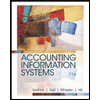
Exercise 2-20 Identifying effects of posting errors on the
Posting errors are identified in the following table. In column (1), enter the amount of the difference between the two trial balance columns (debit and credit) due to the error. In column (2), identify the trial balance column (debit or credit) with the larger amount if they are not equal. In column (3), identify the account(s) affected by the error. In column (4) indicate the amount by which the account(s) in column (3) is under- or overstated. Item (a) is completed as an example.
| Description of Posting Error | (1) |
Difference between Debit and Credit Columns
Column with the Larger Total
Identify account(s) Incorrectly Started
Amount That Account(S) Is Over. Of Understated
Trending nowThis is a popular solution!

Chapter 2 Solutions
Financial and Managerial Accounting
- On January 1, 2024, Maywood Hydraulics leased drilling equipment from Aqua Leasing for a four-year period ending December 31, 2027, at which time possession of the leased asset will revert back to Aqua. • The equipment cost Aqua $423,414 and has an expected economic life of five years. Aqua and Maywood expect the residual value at December 31, 2027, to be $60,000. Negotiations led to Maywood guaranteeing a $85,000 residual value. • Equal payments under the lease are $120,000 and are due on December 31 of each year with the first payment being made on December 31, 2024. Maywood is aware that Aqua used a 7% interest rate when calculating lease payments. Note: Use tables, Excel, or a financial calculator. (FV of $1, PV of $1, FVA of $1, PVA of $1, FVAD of $1 and PVAD of $1) Required: 1. & 2. Prepare the appropriate entries for Maywood on January 1, 2024 and December 31, 2024, related to the lease. Note: If no entry is required for a transaction/event, select "No journal entry required" in…arrow_forwardWhat is the break even point in sales provide answerarrow_forwardhelp me to solve this questionsarrow_forward
 Auditing: A Risk Based-Approach (MindTap Course L...AccountingISBN:9781337619455Author:Karla M Johnstone, Audrey A. Gramling, Larry E. RittenbergPublisher:Cengage Learning
Auditing: A Risk Based-Approach (MindTap Course L...AccountingISBN:9781337619455Author:Karla M Johnstone, Audrey A. Gramling, Larry E. RittenbergPublisher:Cengage Learning Accounting Information SystemsFinanceISBN:9781337552127Author:Ulric J. Gelinas, Richard B. Dull, Patrick Wheeler, Mary Callahan HillPublisher:Cengage Learning
Accounting Information SystemsFinanceISBN:9781337552127Author:Ulric J. Gelinas, Richard B. Dull, Patrick Wheeler, Mary Callahan HillPublisher:Cengage Learning College Accounting, Chapters 1-27AccountingISBN:9781337794756Author:HEINTZ, James A.Publisher:Cengage Learning,
College Accounting, Chapters 1-27AccountingISBN:9781337794756Author:HEINTZ, James A.Publisher:Cengage Learning,


